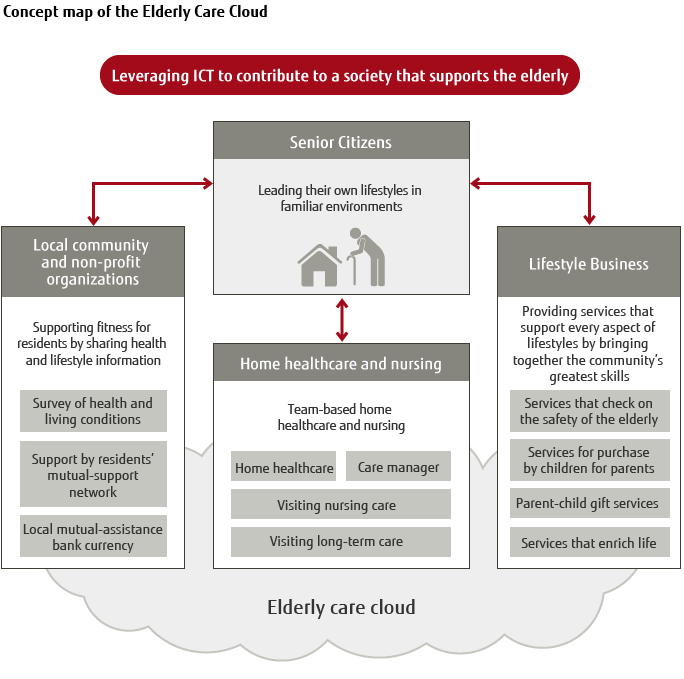Archived content
NOTE: this is an archived page and the content is likely to be out of date.
The Power to Shape the Future
Key Examples from FY 2012
contents
- Flood Disaster Mitigation using Meteorological Simulations (Australia)
- Supporting High-Quality, High-Productivity Greenhouse Horticulture with "Akisai"
- Sustainable Urban Development Using Big Data (Singapore)
- Rising to the Challenge of Creating a Community Where Everyone in Need of Nursing Care Can Live
with a Sense of Security - Creating a Personal Health Record System to Make Preventive Medicine a Reality (Finland)
- Reducing Electricity Usage to Address Environmental Change
- Using an Artificial Brain to Contribute to More Humane Working and Living Conditions
- Using the Cloud to Promote Convenience and Business Continuity for Monozukuri (Manufacturing)
- Leveraging ICT to contribute to a society that supports the elderly on the frontline of home healthcare
and nursing.
Flood Disaster Mitigation using Meteorological Simulations (Australia)
Flood disasters due to climate change and urbanization have been increasing in the recent years. In 2010, for example, approximately 200 million people in the world fell victim to flooding. Australia, where approximately 80% of the population is concentrated in coastal areas, was no exception. 8, Abnormal precipitation is a growing cause of flood disasters there and decreasing flood-related risks is of considerable importance to the nation.
Fujitsu, in collaboration with the National Computational Infrastructure (NCI) led by the Australian National University (ANU), is focusing on climate change, disaster prevention, and flood research using meteorological simulation. NCI's new supercomputer, constructed with Fujitsu in June 2012, offers peak performance of 1.2 Pflops and is the most powerful system in the Southern Hemisphere, Fujitsu, in its partnership with NCI, expects that this system will provide accurate weather forecast simulations for better disaster prevention, prompt responses to flooding, and a greater understanding of the environmental challenges facing Australia.
By utilizing these HPC technologies, Fujitsu aims to contribute to the mitigation of flood disasters in Australia, and many other countries around the world
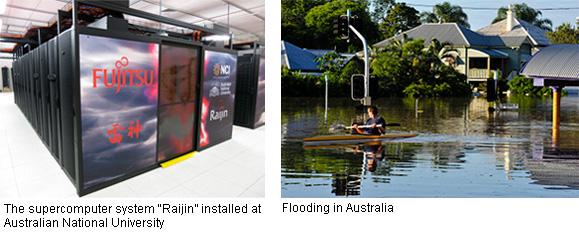
Supporting High-Quality, High-Productivity Greenhouse Horticulture with "Akisai"
The percent of Japan's population engaged in agriculture is both declining (comprises about 2% of the total) and aging (average age greater than 65). Boosting the industry with increases in agricultural productivity, therefore, is an urgent matter.
In the Miyagi Prefecture town of Yamamoto, where greenhouse-based production of tomatoes and strawberries is a thriving industry, producers were in need of a system capable of finely controlling greenhouse temperatures, humidity, sunlight, and other growing conditions to improve supply stability and production efficiency.
In response to that need, Fujitsu began offering greenhouse horticulture service as a new solution for "Akisai" food and agriculture cloud platform, in October 2012. This service, by measuring and accumulating greenhouse environmental data in a cloud, enables the use of this data for controlling greenhouse environmental conditions.
This system employs the new Ubiquitous Environmental Control System (UECS) *1 information standard for plant cultivation. UECS enables the use of a smartphone and other devices to remotely manipulate devices and equipment for controlling temperature, levels of sunlight, and other environmental conditions. "Akisai" saves labor and promotes high-quality, low-cost production activity that is also stable.
Through ICT, Fujitsu aims to continue helping to bring about a plentiful future for food.
*1 Ubiquitous Environmental Control System (UECS):
Japan's primary communications standard for greenhouse cultivation. Compared to conventional centralized management approaches, UECS excels in terms of low implementation cost, ease of installation, and low maintenance.
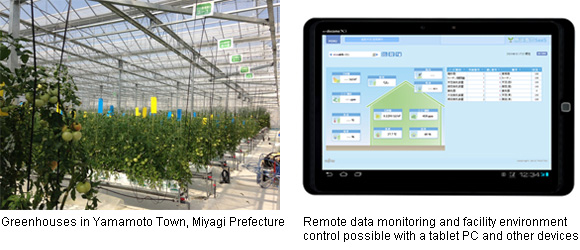
Sustainable Urban Development Using Big Data (Singapore)
As of 2012, 52% of the world's population lives in cities. With this figure expected to rise to 60% by 2030, there are concerns that such rapid urbanization will only exacerbate traffic congestion, environmental pollution, and other urban problems. Creating sustainable cities, therefore, is an issue with global proportions.
In March 2013, Fujitsu entered into discussions with Singapore's Agency for Science, Technology and Research on the establishment of a Center of Excellence for creating urban development solutions.
In providing Fujitsu's computer simulation technology and expertise in applying big data, our aim is to create solutions for managing transportation and energy networks, building greener urban spaces, minimizing disaster damage, creating new business, and meeting other needs of urban environments.
Looking to the future, Fujitsu intends to continue contributing to sustainable regional development in Asia and other parts of the world, as well.
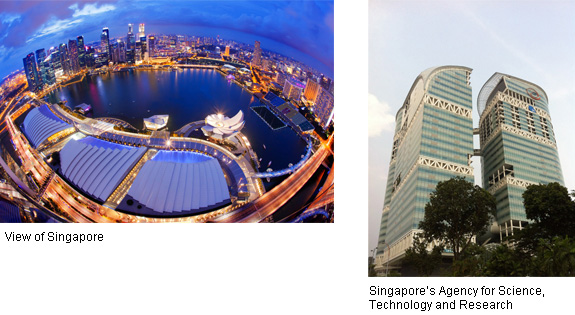
Rising to the Challenge of Creating a Community Where Everyone in Need of Nursing Care Can Live with a Sense of Security
In Japan, which leads the world in population aging, seniors *2 now comprise 24% of the population and are projected to make up 32% by 2030. Visiting care and visiting nursing care services play important roles in providing health care in rural communities, where hospitals are lacking or access to them is impractical. Care providers and nurses, however, can visit no more than about 50 patients a day, and are, therefore, significantly overmatched when it comes to meeting patient needs.
Fujitsu, therefore, joined with Kouseikai, a provider of medical services in Yao City, Osaka Prefecture, to develop a visiting nursing care system that, by linking a care support system and system for requesting assistance, speeds the acquisition of a patient's current and past medical data, selection of care providers, designation of the route to the patient's location, and issuance of care instructions. This system became available in December 2012 and, since then, has not only increased the number of patient visits per day by 240% but also facilitated the ability to provide patients with high-quality services and a sense of security.
Moving ahead, Fujitsu will continue working to improve quality of life by applying this system to preventive medicine to extend possibilities for people to continue living in their homes as long as possible.
*2 Seniors:
People age 65 or older.
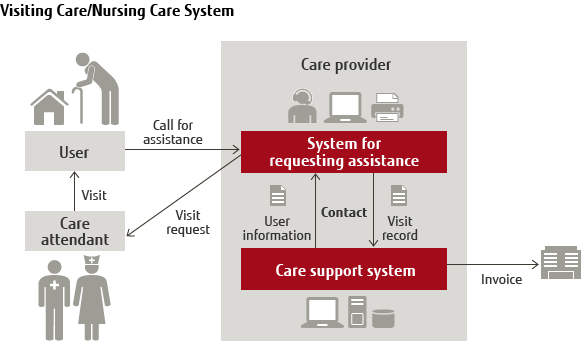
Creating a Personal Health Record System to Make Preventive Medicine a Reality (Finland)
Preventive medicine that manages daily-life practices has become the focus of attention as an approach for preventing lifestyle-related diseases and heading off increases in future medical costs.
In advanced countries, which lead the world in population aging, preventive medicine for managing daily living habits is drawing attention as a way to prevent lifestyle-related diseases and rise in medical costs.
In Finland, the Taltioni Cooperative was considering possibilities for building a Personal Health Record (PHR) system that would consolidate individuals' health and medical information from various medical and service institutions, and make preventive medicine and effective follow-up care a reality.
Fujitsu undertook a project in which we would develop and operate the Taltioni service, which would allow individuals to manage their health and medical data online. We built a highly secure platform, and made the service available beginning in January 2013. As a result, ordinary people can now use a tablet PC and other devices for daily entry and management of health condition, diet, exercise, and other data indispensable for health maintenance. Also, this system is designed to link it to hospital medical data to enable comprehensive health management covering prevention, as well as treatment and follow-up care.
Moving forward, Fujitsu aims to continue with its efforts to apply ICT for the improvement of medical and health services.
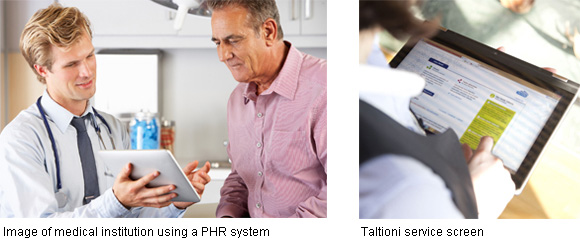
Reducing Electricity Usage to Address Environmental Change
Urban areas now account for two thirds of all of the energy used in the world and are a major source of greenhouse gases. Japan, however, reducing its electricity consumption in response not only to those circumstances but also to electricity shortages and resulting higher rates following the Great East Japan Earthquake.
In response, Fujitsu has developed an energy management system (EMS) service called, Enetune. This cloud-based service provides integrative and cross-sectional visual representations of data on electricity consumption. Available since June 2012, Enetune enables the centralized management of energy data for all of a company's business locations, including leased or rented buildings and retail locations.
In a related development, a consortium of 15 companies led by Fujitsu was chosen in April 2012 as a BEMS aggregator *1 under a Ministry of Economy, Trade and Industry subsidy program for promoting the introduction of energy management systems. That means it is now easier for electricity users with less than 500kW of demand to introduce an EMS.
Fujitsu intends to continue with such efforts moving forward to make cities more efficient users of electricity and other energy, and contribute to the realization of smart cities.
*1 BEMS aggregator:
Manager/operator of a Building and Energy Management System. Promotes the introduction of cloud-based energy management systems.
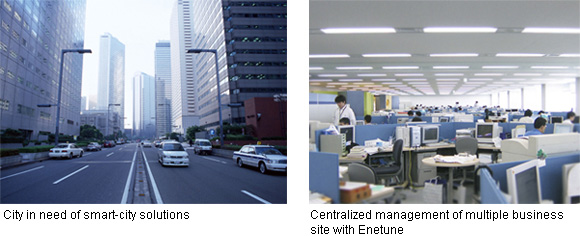
Using an Artificial Brain to Contribute to More Humane Working and Living Conditions
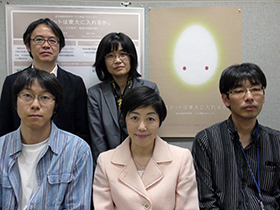
Mathematics team members for the "Can a Robot Pass the University of Tokyo Entrance Exam"
Fujitsu believes that the use of artificial intelligence will support thinking and decision-making, accelerate the creation of new knowledge, and holds the key to working and living in more humane ways.
Therefore, as a part of our research efforts along these lines, Fujitsu Laboratories joined the National Institute of Informatics' artificial brain project, "Can a Robot Pass the University of Tokyo Entrance Exam", in 2012. As a math team member, we are working to develop a program that uses natural-language processing and computer algebra technologies to solve math problems automatically.
Progress in this research will contribute to efforts to develop an artificial-brain robot that can understand imprecise human language, respond to various problems, and ultimately provide humans with assistance that makes daily life safer, more convenient and more secure.
Through efforts such as this, Fujitsu aims to use ICT to improve the ways in which we work and live, and open the door to major expansions of human capabilities and potential.
Using the Cloud to Promote Convenience and Business Continuity for Monozukuri (Manufacturing)
In the wake of the Great East Japan Earthquake, companies are paying much greater attention to Business Continuity Planning (BCP), specifically with natural disasters in mind. But even as large companies move forward with BCP development, the small and medium-size enterprises that make up 99.7% of all companies in Japan are finding the process fraught with hurdles. This is particularly true for manufacturing companies, where high investments in capital have been the issue to overcome.
Fujitsu, therefore, joined with ALPS Electric Co., Ltd., Tokyo Electron Limited, and the Miyagi Prefectural Government's Industrial Technology Institute to undertake a pilot project for combining IT and Monozukuri (manufacturing), beginning in March 2012. Together, the project participants built a public cloud, where users can access high-performance computers, 3-D and other CAD software, various types of simulation software, and other advanced design tools with a personal computer and an Internet connection. Measurements of actual usage taken by the product designers showed that the 3-D CAD and other software offerings could be used with no significant problems via an Internet connection.
Cloud environments not only hold down ICT adoption expenses; they also provide places for systems and data to safely reside. When a natural disaster strikes, therefore, the fact that a cloud environment has been used contributes to the rapid resumption of product development processes and manufacturing operations. Going forward, the system discussed above will be used to help enhance the robustness of small and medium enterprises throughout Japan.
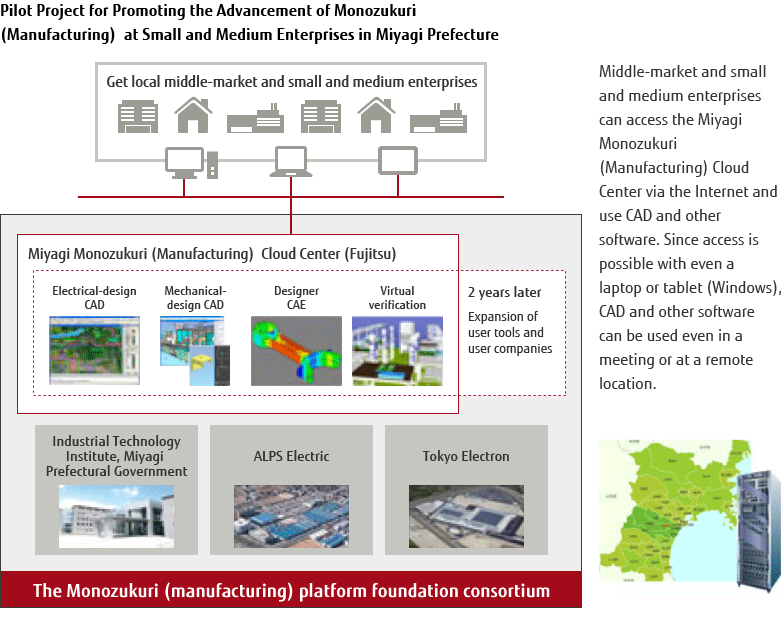
Leveraging ICT to contribute to a society that supports the elderly on the frontline of home healthcare and nursing.
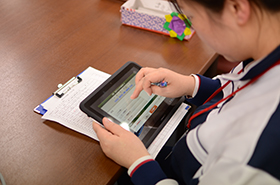
Sharing of users' vital information in a cloud
With the number of people aged 65 and over now comprising 24% of its population, Japan is becoming a "super aging society." Total social welfare benefit cost to care for the elderly amounted to 35 trillion yen in 2012, and this figure is steadily increasing each year. Japan must support its elderly population amid limited medical resources, and it is expected that collaboration between existing hospital-based medical care, and home healthcare and nursing, will be enhanced as a national effort.
Through the experience Fujitsu gained over the past two years in using ICT in senior care on the front lines of home healthcare and in areas stricken by the Great East Japan Earthquake, we have developed a new cloud service named "Fujitsu Intelligent Society Solution Senior Care Cloud Oushin Sensei" in collaboration with Shinsuke Muto, president of You Home Clinic, Tetsuyu Institute Medical Corporation, that comprehensively supports the health and lifestyles of senior citizens through home healthcare and nursing services.
Launched in January 2013, this service has facilitated both role-sharing and information coordination for doctors and staff members and maximized the time that doctors spend together with patients. It enables the improvement of the quality of home healthcare services and enhance of teamwork in supporting the elderly by linking information collected by home healthcare and nursing staff.
Through this service, Fujitsu aims to realize a society that supports the elderly by improving the quality of home healthcare services, while reducing the burden on caregivers, and allowing the elderly to safely live in familiar environments.
